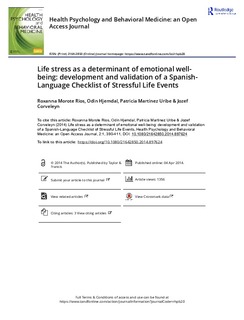| dc.contributor.author | Rios, Roxanna Morote | |
| dc.contributor.author | Hjemdal, Odin | |
| dc.contributor.author | Uribe, Patricia Martinez | |
| dc.contributor.author | Corveleyn, Jozef | |
| dc.date.accessioned | 2019-11-08T08:11:54Z | |
| dc.date.available | 2019-11-08T08:11:54Z | |
| dc.date.created | 2014-09-29T13:19:53Z | |
| dc.date.issued | 2014 | |
| dc.identifier.citation | Health Psychology and Behavioral Medicine. 2014, 2 (1), 390-411. | nb_NO |
| dc.identifier.issn | 2164-2850 | |
| dc.identifier.uri | http://hdl.handle.net/11250/2627300 | |
| dc.description.abstract | Objectives: To develop a screening instrument for investigating the prevalence and impact of stressful life events in Spanish-speaking Peruvian adults. Background: Researchers have demonstrated the causal connection between life stress and psychosocial and physical complaints. The need for contextually relevant and updated instruments has been also addressed. Methods: A sequential exploratory design combined qualitative and quantitative information from two studies: first, the content validity of 20 severe stressors (N = 46); then, a criterion-related validity process with affective symptoms as criteria (Hopkins Symptom Checklist (HSCL-25), N = 844). Results: 93% of the participants reported one to eight life events (X = 3.93, Mdn = 3, SD = 7.77). Events increase significantly until 60 years of age (Mdn = 6). Adults born in inland regions (Mdn = 4) or with secondary or technical education (Mdn = 5) reported significantly more stressors than participants born in Lima or with higher education. There are no differences by gender. Four-step hierarchical models showed that life stress is the best unique predictor (β) of HSCL anxiety, depression and general distress (p < .001). Age and gender are significant for the three criteria (p < .01, p < .001); lower education and unemployment are significant unique predictors of general distress and depression (p < .01; p < .05). Previously, the two-factor structure of the HSCL-25 was verified (Satorra–Bentler chi-square, root-mean-square error of approximation = 0.059; standardized root-mean-square residual = 0.055). Conclusion: The Spanish-Language Checklist of Stressful Life Events is a valid instrument to identify adults with significant levels of life stress and possible risk for mental and physical health (clinical utility). | nb_NO |
| dc.language.iso | eng | nb_NO |
| dc.publisher | Taylor & Francis | nb_NO |
| dc.rights | Navngivelse 4.0 Internasjonal | * |
| dc.rights.uri | http://creativecommons.org/licenses/by/4.0/deed.no | * |
| dc.title | Life stress as a determinant of emotional well-being: development and validation of a Spanish-Language Checklist of Stressful Life Events | nb_NO |
| dc.type | Journal article | nb_NO |
| dc.type | Peer reviewed | nb_NO |
| dc.description.version | publishedVersion | nb_NO |
| dc.source.pagenumber | 390-411 | nb_NO |
| dc.source.volume | 2 | nb_NO |
| dc.source.journal | Health Psychology and Behavioral Medicine | nb_NO |
| dc.source.issue | 1 | nb_NO |
| dc.identifier.doi | 10.1080/21642850.2014.897624 | |
| dc.identifier.cristin | 1159338 | |
| dc.description.localcode | © 2014 The Author(s). Published by Taylor & Francis This is an open-access article distributed under the terms of the Creative Commons Attribution License http://creativecommons.org/licenses/by/3.0/, which permits unrestricted use, distribution, and reproduction in any medium, provided the original work is properly cited. The moral rights of the named author(s) have been asserted. | nb_NO |
| cristin.unitcode | 194,67,40,0 | |
| cristin.unitname | Institutt for psykologi | |
| cristin.ispublished | true | |
| cristin.fulltext | original | |
| cristin.qualitycode | 1 | |

